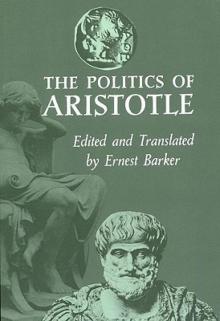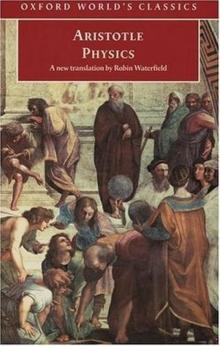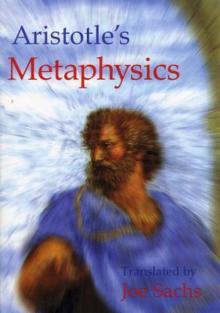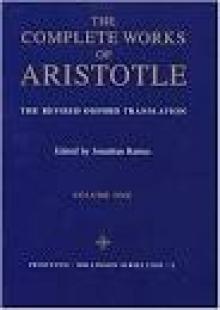Various Works Read online
Page 63
things; one naturally exists prior to another. But the word 'prior' is
used in more senses than one. For there is a difference between the
end or final cause and that which exists for the sake of it; the
latter is prior in order of development, the former is prior in
reality. Again, that which exists for the sake of the end admits of
division into two classes, (1) the origin of the movement, (2) that
which is used by the end; I mean, for instance, (1) that which can
generate, (2) that which serves as an instrument to what is generated,
for the one of these, that which makes, must exist first, as the
teacher before the learner, and the other later, as the pipes are
later than he who learns to play upon them, for it is superfluous that
men who do not know how to play should have pipes. Thus there are
three things: first, the end, by which we mean that for the sake of
which something else exists; secondly, the principle of movement and
of generation, existing for the sake of the end (for that which can
make and generate, considered simply as such, exists only in
relation to what is made and generated); thirdly, the useful, that is
to say what the end uses. Accordingly, there must first exist some
part in which is the principle of movement (I say a part because this
is from the first one part of the end and the most important part
too); next after this the whole and the end; thirdly and lastly,
the organic parts serving these for certain uses. Hence if there is
anything of this sort which must exist in animals, containing the
principle and end of all their nature, this must be the first to
come into being- first, that is, considered as the moving power, but
simultaneous with the whole embryo if considered as a part of the end.
Therefore all the organic parts whose nature is to bring others into
being must always themselves exist before them, for they are for the
sake of something else, as the beginning for the sake of the end;
all those parts which are for the sake of something else but are not
of the nature of beginnings must come into being later. So it is not
easy to distinguish which of the parts are prior, those which are
for the sake of another or that for the sake of which are the
former. For the parts which cause the movement, being prior to the end
in order of development, come in to cause confusion, and it is not
easy to distinguish these as compared with the organic parts. And
yet it is in accordance with this method that we must inquire what
comes into being after what; for the end is later than some parts
and earlier than others. And for this reason that part which
contains the first principle comes into being first, next to this
the upper half of the body. This is why the parts about the head,
and particularly the eyes, appear largest in the embryo at an early
stage, while the parts below the umbilicus, as the legs, are small;
for the lower parts are for the sake of the upper, and are neither
parts of the end nor able to form it.
But they do not say well nor do they assign a necessary cause who
say simply that 'it always happens so', and imagine that this is a
first principle in these cases. Thus Democritus of Abdera says that
'there is no beginning of the infinite; now the cause is a
beginning, and the eternal is infinite; in consequence, to ask the
cause of anything of this kind is to seek for a beginning of the
infinite'. Yet according to this argument, which forbids us to seek
the cause, there will be no proof of any eternal truth whatever; but
we see that there is a proof of many such, whether by 'eternal' we
mean what always happens or what exists eternally; it is an eternal
truth that the angles of a triangle are always equal to two right
angles, or that the diagonal of a square is incommensurable with the
side, and nevertheless a cause and a proof can be given for these
truths. While, then, it is well said that we must not take on us to
seek a beginning (or first principle) of all things, yet this is not
well said of all things whatever that always are or always happen, but
only of those which really are first principles of the eternal things;
for it is by another method, not by proof, that we acquire knowledge
of the first principle. Now in that which is immovable and
unchanging the first principle is simply the essence of the thing, but
when we come to those things which come into being the principles
are more than one, varying in kind and not all of the same kind; one
of this number is the principle of movement, and therefore in all
the sanguinea the heart is formed first, as was said at the beginning,
and in the other animals that which is analogous to the heart.
From the heart the blood-vessels extend throughout the body as in
the anatomical diagrams which are represented on the wall, for the
parts lie round these because they are formed out of them. The
homogeneous parts are formed by heat and cold, for some are put
together and solidified by the one and some by the other. The
difference between these has already been discussed elsewhere, and
it has been stated what kinds of things are soluble by liquid and
fire, and what are not soluble by liquid and cannot be melted by fire.
The nutriment then oozes through the blood-vessels and the passages in
each of the parts, like water in unbaked pottery, and thus is formed
the flesh or its analogues, being solidified by cold, which is why
it is also dissolved by fire. But all the particles given off which
are too earthy, having but little moisture and heat, cool as the
moisture evaporates along with the heat; so they become hard and
earthy in character, as nails, horns, hoofs, and beaks, and
therefore they are softened by fire but none of them is melted by
it, while some of them, as egg-shells, are soluble in liquids. The
sinews and bones are formed by the internal heat as the moisture
dries, and hence the bones are insoluble by fire like pottery, for
like it they have been as it were baked in an oven by the heat in
the process of development. But it is not anything whatever that is
made into flesh or bone by the heat, but only something naturally
fitted for the purpose; nor is it made in any place or time
whatever, but only in a place and time naturally so fitted. For
neither will that which exists potentially be made except by that
moving agent which possesses the actuality, nor will that which
possesses the actuality make anything whatever; the carpenter would
not make a box except out of wood, nor will a box be made out of the
wood without the carpenter. The heat exists in the seminal
secretion, and the movement and activity in it is sufficient in kind
and in quantity to correspond to each of the parts. In so far as there
is any deficiency or excess, the resulting product is in worse
condition or physically defective, in like manner as in the case of
external substances which are thickened by boiling that they may be
more palatable or for any other purpose. But in the latter case it
i
s we who apply the heat in due measure for the motion required; in
the former it is the nature of the male parent that gives it, or
with animals spontaneously generated it is the movement and heat
imparted by the right season of the year that it is the cause.
Cooling, again, is mere deprivation of heat. Nature makes use of
both; they have of necessity the power of bringing about different
results, but in the development of the embryo we find that the one
cools and the other heats for some definite purpose, and so each of
the parts is formed; thus it is in one sense by necessity, in
another for a final cause, that they make the flesh soft, the sinews
solid and elastic, the bones solid and brittle. The skin, again, is
formed by the drying of the flesh, like the scum upon boiled
substances; it is so formed not only because it is on the outside, but
also because what is glutinous, being unable to evaporate, remains
on the surface. While in other animals the glutinous is dry, for which
reason the covering of the invertebrates is testaceous or crustaceous,
in the vertebrates it is rather of the nature of fat. In all of
these which are not of too earthy a nature the fat is collected
under the covering of the skin, a fact which points to the skin
being formed out of such a glutinous substance, for fat is somewhat
glutinous. As we said, all these things must be understood to be
formed in one sense of necessity, but in another sense not of
necessity but for a final cause.
The upper half of the body, then, is first marked out in the order
of development; as time goes on the lower also reaches its full size
in the sanguinea. All the parts are first marked out in their outlines
and acquire later on their colour and softness or hardness, exactly as
if Nature were a painter producing a work of art, for painters, too,
first sketch in the animal with lines and only after that put in the
colours.
Because the source of the sensations is in the heart, therefore this
is the part first formed in the whole animal, and because of the
heat of this organ the cold forms the brain, where the blood-vessels
terminate above, corresponding to the heat of the heart. Hence the
parts about the head begin to form next in order after the heart,
and surpass the other parts in size, for the brain is from the first
large and fluid.
There is a difficulty about what happens with the eyes of animals.
Though from the beginning they appear very large in all creatures,
whether they walk or swim or fly, yet they are the last of the parts
to be formed completely, for in the intervening time they collapse.
The reason is this. The sense-organ of the eyes is set upon certain
passages, as are the other sense-organs. Whereas those of touch and
taste are simply the body itself or some part of the body of
animals, those of smell and hearing are passages connecting with the
external air and full themselves of innate spiritus; these passages
end at the small blood-vessels about the brain which run thither
from the heart. But the eye is the only sense-organ that has a
bodily constitution peculiar to itself. It is fluid and cold, and does
not exist from the first in the place which it occupies later in the
same way as the other parts do, for they exist potentially to begin
with and actually come into being later, but the eye is the purest
part of the liquidity about the brain drained off through the passages
which are visible running from them to the membrane round the brain. A
proof of this is that, apart from the brain, there is no other part in
the head that is cold and fluid except the eye. Of necessity therefore
this region is large at first but falls in later. For the same thing
happens with the brain; at first it is liquid and large, but in course
of evaporation and concoction it becomes more solid and falls in; this
applies both to the brain and the eyes. The head is very large at
first, on account of the brain, and the eyes appear large because of
the liquid in them. They are the last organs to reach completion
because the brain is formed with difficulty; for it is at a late
period that it gets rid of its coldness and fluidity; this applies
to all animals possessing a brain, but especially to man. For this
reason the 'bregma' is the last of the bones to be formed; even
after birth this bone is still soft in children. The cause of this
being so with men more than with other animals is the fact that
their brain is the most fluid and largest. This again is because the
heat in man's heart is purest. His intellect shows how well he is
tempered, for man is the wisest of animals. And children for a long
time have no control over their heads on account of the heaviness of
the brain; and the same applies to the parts which it is necessary
to move, for it is late that the principle of motion gets control over
the upper parts, and last of all over those whose motion is not
connected directly with it, as that of the legs is not. Now the eyelid
is such a part. But since Nature makes nothing superfluous nor in
vain, it is clear also that she makes nothing too late or too soon,
for if she did the result would be either in vain or superfluous.
Hence it is necessary that the eyelids should be separated at the same
time as the heart is able to move them. So then the eyes of animals
are perfected late because of the amount of concoction required by the
brain, and last of all the parts because the motion must be very
strong before it can affect parts so far from the first principle of
motion and so cold. And it is plain that such is the nature of the
eyelids, for if the head is affected by never so little heaviness
through sleepiness or drunkenness or anything else of the kind, we
cannot raise the eyelids though their own weight is so small. So
much for the question how the eyes come into being, and why and for
what cause they are the last to be fully developed.
Each of the other parts is formed out of the nutriment, those most
honourable and participating in the sovereign principle from the
nutriment which is first and purest and fully concocted, those which
are only necessary for the sake of the former parts from the
inferior nutriment and the residues left over from the other. For
Nature, like a good householder, is not in the habit of throwing
away anything from which it is possible to make anything useful. Now
in a household the best part of the food that comes in is set apart
for the free men, the inferior and the residue of the best for the
slaves, and the worst is given to the animals that live with them.
Just as the intellect acts thus in the outside world with a view to
the growth of the persons concerned, so in the case of the embryo
itself does Nature form from the purest material the flesh and the
body of the other sense-organs, and from the residues thereof bones,
sinews, hair, and also nails and hoofs and the like; hence these are
last to assume their form, for they have to wait till the time when
Nature has
some residue to spare.
The bones, then, are made in the first conformation of the parts
from the seminal secretion or residue. As the animal grows the bones
grow from the natural nourishment, being the same as that of the
sovereign parts, but of this they only take up the superfluous
residues. For everywhere the nutriment may be divided into two
kinds, the first and the second; the former is 'nutritious', being
that which gives its essence both to the whole and to the parts; the
latter is concerned with growth, being that which causes
quantitative increase. But these must be distinguished more fully
later on. The sinews are formed in the same way as the bones and out
of the same materials, the Seminal and nutritious residue. Nails,
hair, hoofs, horns, beaks, the spurs of cocks, and any other similar
parts, are on the contrary formed from the nutriment which is taken
later and only concerned with growth, in other words that which is
derived from the mother, or from the outer world after birth. For this
reason the bones on the one hand only grow up to a certain point (for
there is a limit of size in all animals, and therefore also of the
growth of the bones; if these had been always able to grow, all
animals that have bone or its analogue would grow as long as they
lived, for these set the limit of size to animals. What is the
reason of their not always increasing in size must be stated later.)
Hair, on the contrary, and growths akin to hair go on growing as long
as they exist at all, and increase yet more in diseases and when the
body is getting old and wasting, because more residual matter is
left over, as owing to old age and disease less is expended on the
important parts, though when the residual matter also fails through
age the hair fails with it. But the contrary is the case with the
bones, for they waste away along with the body and the other parts.
Hair actually goes on growing after death; it does not, however, begin
growing then.
About the teeth a difficulty may be raised. They have actually the
same nature as the bones, and are formed out of the bones, but
nails, hair, horns, and the like are formed out of the skin, and

 On Sophistical Refutations
On Sophistical Refutations The Categories
The Categories The Politics of Aristotle
The Politics of Aristotle Nicomachean Ethics
Nicomachean Ethics The Rhetoric & the Poetics of Aristotle
The Rhetoric & the Poetics of Aristotle POSTERIOR ANALYTICS
POSTERIOR ANALYTICS Physics
Physics Metaphysics
Metaphysics Various Works
Various Works